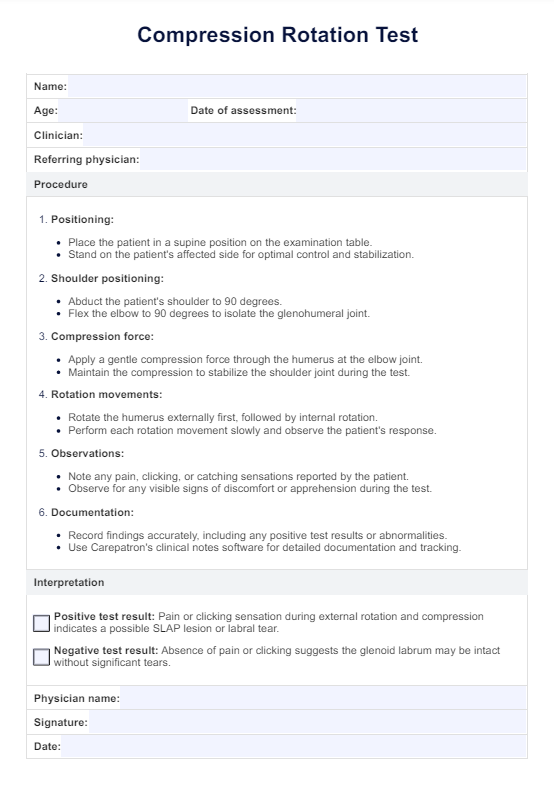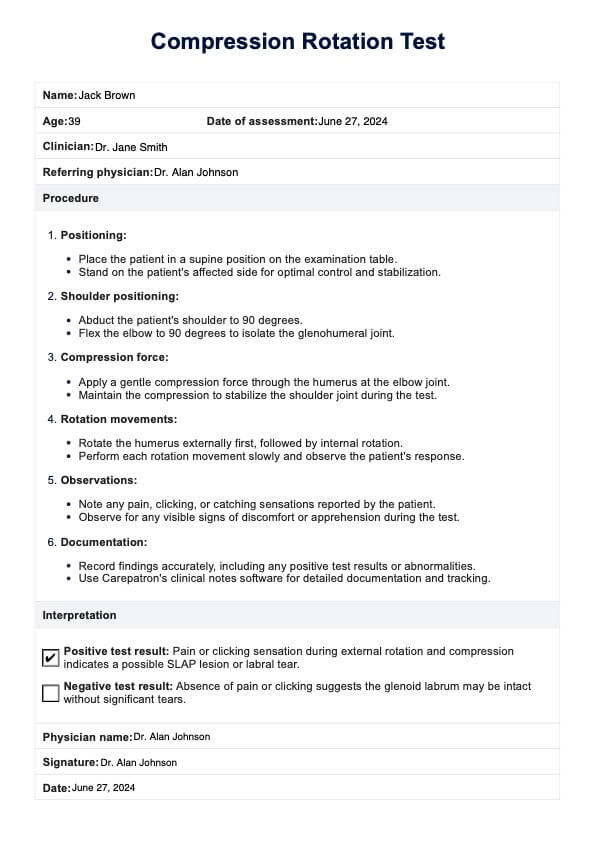Compression Rotation Test
Learn about the compression rotation test, its purpose, methods, and an example. Download Carepatron's free PDF for reference.


What are SLAP lesions?
SLAP lesions, or Superior Labrum Anterior and Posterior lesions, are injuries to the superior labrum of the shoulder joint. The labrum is a ring of cartilage that surrounds the glenoid cavity, providing stability to the shoulder by securing the ball of the humerus in the socket. A SLAP tear occurs at the point where the biceps tendon attaches to the labrum, often resulting from repetitive shoulder motions or acute trauma. This type of labral pathology can significantly impair shoulder function and cause pain.
How to assess SLAP lesions
Assessing SLAP lesions involves a series of clinical evaluations and diagnostic tests to accurately identify the presence and extent of the injury. Here are the key steps and methods used to assess SLAP lesions:
- Patient history and symptoms: Begin by taking a thorough patient history, focusing on any incidents of shoulder trauma, repetitive overhead activities, and symptoms such as pain, clicking, or a feeling of instability in the shoulder.
- Physical examination: Conduct a detailed physical examination of the shoulder to check for tenderness, range of motion, and strength. Look for signs of discomfort during specific movements.
- Compression Rotation Test: A positive test, indicated by pain or clicking, suggests a potential SLAP tear. The procedure for this can be found in our template and in a previous section of this guide.
- Crank test: Another useful test is the crank test, where the shoulder is elevated to 160 degrees and a compressive load is applied while rotating the humerus. Pain or a grinding sensation indicates superior labral tears.
- O'Brien’s test: This test involves the patient flexing their shoulder to 90 degrees with the elbow extended and then internally rotating the arm. The examiner applies downward force; pain or a click in this position can indicate a torn labrum.
- Magnetic resonance imaging (MRI): An MRI scan provides detailed images of the shoulder's internal structures, helping to confirm the presence and severity of a SLAP lesion.
- Arthroscopy: In some cases, an arthroscopic examination may be necessary. This minimally invasive procedure allows direct visualization of the superior labrum and can confirm the diagnosis of a SLAP tear.
By following these steps, healthcare practitioners can accurately assess SLAP lesions and determine the most appropriate treatment plan for their patients.
Compression Rotation Test Template
Compression Rotation Test Example
What is the Compression Rotation Test?
The Compression Rotation Test is a diagnostic procedure used to identify labral pathology, particularly SLAP lesions, in the shoulder. It is one of the special tests performed to assess the integrity of the glenoid labrum and the stability of the glenohumeral joint. During the compression test, the patient lies in a supine position with their shoulder abducted to 90 degrees and the elbow flexed to 90 degrees. The examiner places one hand on the patient's elbow and the other on the AC joint for stabilization.
The test involves applying a compression force through the humerus while simultaneously rotating it externally and internally. This maneuver aims to trap and compress the torn labrum between the glenoid and the humeral head, eliciting pain or a clicking sensation if a labral tear is present. A positive result indicates potential damage to the glenoid labrum, suggesting the need for further evaluation or intervention.
The Compression Rotation Test is valuable in the clinical setting for identifying shoulder injuries and guiding subsequent treatment, which may include manual therapy or surgical repair.
How to perform the Compression Rotation Test
Performing the Compression Rotation Test involves a series of steps to accurately diagnose potential SLAP lesions in the shoulder. Here is a detailed guide:
Step 1: Position the patient
Have the patient lie in a supine position on an examination table. The examiner should stand on the side of the patient's affected shoulder to ensure proper positioning and control during the test.
Step 2: Abduct the shoulder
Bring the patient’s shoulder into 90 degrees of abduction. Ensure that the elbow is also flexed to 90 degrees. This positioning is crucial for effectively isolating the glenohumeral joint during the test.
Step 3: Apply compression force
The examiner should apply a compression force through the humerus by placing one hand on the patient's elbow. This compression is necessary to trap the glenoid labrum between the humeral head and the glenoid cavity.
Step 4: Rotate the humerus
Using the other hand, the examiner should grasp the patient's wrist and rotate the humerus. Perform two repeated movements of internal and external rotation. This action aims to elicit any pain or clicking sensation that might indicate a torn labrum.
Download Carepatron's template
For accurate documentation and to ensure all necessary steps are followed, download Carepatron's Compression Rotation Test template. This resource provides a structured format for recording findings and helps maintain consistency in performing and documenting the test.
Results and interpretations of the Compression Rotation Test
The results of the Compression Rotation Test are interpreted based on the presence or absence of specific signs and symptoms. A positive test result occurs when the examiner detects catching or snapping sensations during the test, akin to the findings in the McMurray test for the knee. This suggests potential pathology involving the superior labrum, such as a SLAP lesion or other forms of labral tear.
Positive findings may warrant further evaluation or referral to a specialist for comprehensive management and treatment planning, which may include conservative measures such as physical therapy or, in more severe cases, surgical intervention.
Benefits of using our template
Carepatron’s Compression Rotation Test template offers several advantages for healthcare practitioners conducting shoulder assessments.
The template guides the examiner through positioning the patient correctly, ensuring the shoulder is abducted to 90 degrees with the elbow flexed, which is critical for maintaining consistency and accuracy in test administration. This standardized approach enhances the reliability of test results and facilitates easier interpretation.
Additionally, Carepatron’s template aids in documenting findings such as pain or clicking sensations during external rotation and compression tests. This documentation is crucial for tracking changes over time and comparing results between assessments.
Treatment of SLAP lesions
SLAP lesions, or Superior Labrum Anterior and Posterior lesions, require careful consideration in treatment to restore shoulder function and alleviate symptoms. Here are some primary treatment options:
Non-surgical treatment
Non-surgical approaches are typically considered first-line for SLAP lesions that are not causing significant functional impairment. Such can include physical therapy, activity modification, and anti-inflammatory medications.
Surgical treatment
If the compression test results are more complicated, surgical treatments might be needed. Such can be arthroscopic repair, debridement, and biceps tenodesis.
Rehabilitation
Following surgery or as part of conservative management, rehabilitation is crucial. Postoperative rehabilitation focuses on restoring strength, range of motion, and shoulder stability through a structured program supervised by a physical therapist.
Commonly asked questions
The Compression Rotation Test assesses for labral tears, particularly SLAP lesions, by applying a compression force while rotating the humerus to provoke pain or clicking indicative of labral pathology.
The special test commonly used for detecting labral tears, including SLAP lesions, is the Compression Rotation Test. It helps identify instability or damage in the glenoid labrum of the shoulder joint.
No, the Compression Rotation Test and the Crank Test are different. While both tests evaluate the integrity of the glenoid labrum, they involve distinct maneuvers and positions to assess specific types of labral pathology and shoulder instability.







































































































